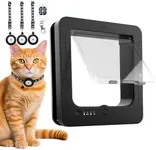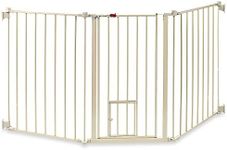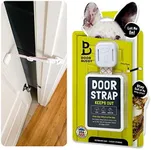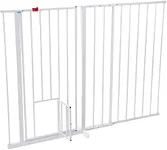Buying Guide for the Best Collar Activated Dog Doors
Choosing the right collar-activated dog door for your pet can greatly enhance convenience and security. These doors allow your dog to come and go freely while keeping out unwanted animals and intruders. To make an informed decision, it's important to understand the key specifications and how they align with your needs and your pet's habits.SizeThe size of the dog door is crucial because it needs to be large enough for your dog to pass through comfortably but not so large that it compromises security. Measure your dog's height and width to ensure the door is a good fit. Small doors are suitable for small breeds, medium doors for medium breeds, and large doors for large breeds. If you have a growing puppy, consider a door that will accommodate their adult size.
MaterialThe material of the dog door affects its durability and insulation properties. Common materials include plastic, aluminum, and composite. Plastic doors are lightweight and affordable but may not be as durable. Aluminum doors are more robust and weather-resistant, making them ideal for active dogs and harsh climates. Composite doors offer a balance of durability and insulation. Choose a material that suits your climate and your dog's activity level.
Security FeaturesSecurity features are important to prevent unwanted animals or intruders from entering your home. Look for doors with locking mechanisms, such as electronic locks that only open for your dog's collar. Some doors also have additional security features like reinforced frames or dual locks. If security is a top concern, opt for a door with advanced locking systems and sturdy construction.
Installation TypeDog doors can be installed in various locations, including doors, walls, and sliding glass doors. The installation type you choose will depend on your home's layout and your preferences. Door-mounted options are the most common and easiest to install. Wall-mounted doors require more effort but offer more placement flexibility. Sliding glass door inserts are convenient for homes with sliding doors. Consider where you want the door installed and choose accordingly.
Power SourceCollar-activated dog doors can be powered by batteries or connected to your home's electrical system. Battery-powered doors are easier to install and can be placed anywhere, but you'll need to replace the batteries periodically. Electrically powered doors offer more consistent performance but require access to a power outlet and may involve more complex installation. Choose a power source that fits your convenience and installation capabilities.
Range and SensitivityThe range and sensitivity of the collar sensor determine how close your dog needs to be for the door to activate. A longer range allows the door to open as your dog approaches, while a shorter range requires your dog to be closer. Sensitivity settings can be adjusted to prevent accidental openings. If your dog is very active or you have multiple pets, a door with adjustable range and sensitivity settings will provide better control.
Weather ResistanceWeather resistance is important to ensure the door can withstand various weather conditions and provide good insulation. Look for doors with weatherproof seals and flaps that prevent drafts and water from entering your home. If you live in an area with extreme weather, choose a door with high-quality insulation and weatherproofing features to maintain energy efficiency and comfort.





















